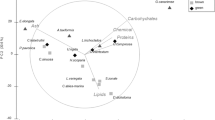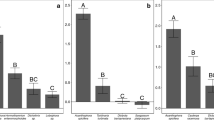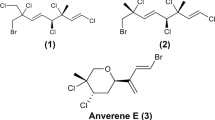Abstract
Because herbivory is more intense in the tropics, tropical seaweeds may be better defended against herbivory than are temperate seaweeds. A “diffuse” coevolutionary corollary to this hypothesis is that tropical herbivores should be more resistant to seaweed defenses than temperate herbivores because tropical herbivores more commonly encounter heavily defended seaweeds. We begin to test the latter prediction using three newly discovered diterpenoid secondary metabolites from the tropical brown alga Dictyota acutiloba. We tested the feeding deterrent properties of these compounds against common herbivorous fishes and sea urchins from warm-temperate North Carolina versus tropical Guam using standardized laboratory feeding assays. The temperate herbivores were deterred by lower concentrations of secondary metabolites than the tropical herbivores. In no case was a tropical herbivore more deterred by a compound than a temperate herbivore, suggesting that temperate herbivores may be more strongly affected by seaweed chemical defenses. Feeding by the temperate pinfish Lagodon rhomboides was significantly reduced by two of the three diterpenes at a concentration that was only 13–18% of the natural concentration found in the alga. Feeding by four species of tropical fishes (two parrotfishes and two surgeonfishes) was unaffected by metabolite concentrations that deterred the temperate fish. At 100% of natural concentrations, only one of the three compounds deterred the two parrotfishes, and none of the three compounds deterred the surgeonfishes. Contrasts between the temperate sea urchin Arbacia punctulata and the tropical sea urchin Diadema savignyi showed a similar pattern; low concentrations of acutilol A acetate strongly deterred the temperate, but not the tropical, urchin. Tropical herbivores appear more resistant than temperate herbivores to seaweed chemical defenses.
Similar content being viewed by others
REFERENCES
BERENBAUMM., and NEALJ. J. 1985. Synergisms between myristicin and xanthotoxin, a naturally co-occurring plant toxicant. J. Chem. Ecol. 11:1349–1358.
BOLSERR., and HAYM. E. 1996. Are tropical plants better defended? Palatability and defenses of temperate versus tropical seaweeds. Ecology 77:2269–2286.
CARPENTERR. C. 1986. Partitioning herbivory and its effects on coral reef algal communities. Ecol. Monogr. 56:345–363.
CARPENTERR. C. 1990. Mass mortality of Diadema antillarum II. Effects on population densities and grazing intensity of parrotfishes and surgeonfishes. Mar. Biol. 104:79–86.
CRONING., and HAYM. E. 1996. Susceptibility to herbivores depends on recent history of both the plant and animal. Ecology 77:1531–1543.
CRONING.LINDQUISTN.HAYM. E., and FENICALW. 1995. Effects of storage and extraction procedures on yields of lipophilic metabolites from the brown seaweeds Dictyota ciliolata and Dictyota menstrualis. Mar. Ecol. Prog. Ser. 119:265–273.
DUFFYJ. E., and HAYM. E. 1990. Seaweed adaptations to herbivory. Bioscience 40:368–375.
DUFFYJ. E., and HAYM. E. 1994. Herbivore resistance to seaweed chemical defense: The roles of mobility and predator risk. Ecology 75:1304–1319.
ESTESJ. A., and STEINBERGP. D. 1988. Predation, herbivory and kelp evolution. Paleobiology 14:19–36.
FAULKNERD. J. 1994. Marine natural productsNat. Prod. Rep. 11:355–394.
HARDTI.FENICALW.CRONING., and HAYM. E. 1996. Acutilols, potent herbivore feeding deterrents from the tropical brown alga Dictyota acutiloba. Phytochemistry 43:71–73.
HATCHERB. G., and LARKUMA. W. D. 1983. An experimental analysis of factors controlling the standing crop of the epilithic algal community on a coral reef. J. Exp. Mar. Biol. Ecol. 69:61–84.
HAYM. E. 1985. Spatial patterns of herbivore impact and their importance in maintaining algal species richness. Proc. 5th Int. Coral Reef Symp. 4:29–34.
HAYM. E. 1991. Fish-seaweed interactions on coral reefs: effects of herbivorous fishes and adaptations of their prey, pp. 96–119in P. F. Sale (ed.). The Ecology of Fishes on Coral Reefs. Academic Press, San Diego.
HAYM. E. 1992. The role of seaweed chemical defenses in the evolution of feeding specialization and in the mediation of complex interactions, pp. 93–118in V. J. Paul (ed.). Ecological Roles of Marine Natural Products. Cornell University Press, Ithaca, New York.
HAYM. E., and FENICALW. 1988. Marine plant-herbivore interactions: The ecology of chemical defense. Annu. Rev. Ecol. Syst. 19:111–145.
HAYM. E., and STEINBERGP. D. 1992. The chemical ecology of plant-herbivore interactions in marine versus terrestrial communities, pp. 371–413in G. A. Rosenthal and M. R. Berenbaum (eds.). Herbivores: Their Interactions with Secondary Plant Metabolites. Vol. II: Evolutionary and Ecological Processes. Academic Press, New York.
HAYM. E., and SUTHERLANDJ. P. 1988. The ecology of rubble structures of the South Atlantic Bight: A community profile. U.S. Fish Wildl. Serv. Biol. Rep. 85(7.20), 67 pp.
HAYM. E., and TAYLORP. R. 1985. Competition between herbivorous fishes and urchins on Caribbean reefs. Oecologia 65:591–598.
HAYM. E.DUFFYJ. D.PFISTERC. A., and FENICALW. 1987. Chemical defense against different marine herbivores: Are amphipods insect equivalents? Ecology 68:1567–1580.
HAYM. E.RENAUDP. E., and FENICALW. 1988. Large mobile versus small sedentary herbivores and their resistance to seaweed chemical defenses. Oecologia 75:246–252.
HAYM. E.DUFFYJ. E., and FENICALW. 1990. Host-plant specialization decreases predation on a marine amphipod: An herbivore in plant's clothing. Ecology 71:733–743.
HAYM. E.KAPPELQ. E., and FENICALW. 1994. Synergisms in plant defenses against herbivores: interactions of chemistry, calcification, and plant quality. Ecology 75:1714–1726.
HIATTR. W., and STRASBURGD. W. 1960. Ecological relationships of the fish fauna on coral reefs of the Marshall Islands. Ecol. Monogr. 30:65–127.
JANZEND. H. 1980. When is it coevolution? Evolution 34:611–612.
JOHND. M.HAWKINSS. J., and PRICEJ. H. (eds.). 1992. Plant-Animal Interactions in the Marine Benthos. Clarendon Press, Oxford.
LUBCHENCOJ., and GAINESS. D. 1981. A unified approach to marine plant-herbivore interactions. I. Populations and communities. Annu. Rev. Ecol. Syst. 12:405–437.
MEYERK. D., and PAULV. J. 1995. Variation in secondary metabolite and aragonite concentrations in the tropical green seaweed Neomeris annulata: Effects on herbivory by fishes. Mar. Biol. 122:537–545.
MEYERK. D.PAULV. J.SANGERH. R., and NELSONS. G. 1994. Effects of seaweed extracts and secondary metabolites on feeding by the herbivorous surgeonfish Naso lituratus. Coral Reefs 13:105–112.
MORRISOND. 1988. Comparing fish and urchin grazing in shallow and deeper coral reef algal communities. Ecology 69:1367–1382.
PAULV. J. (ed.). 1992. Ecological roles for marine natural products. Comstock Press, Ithaca, New York.
PETERSONC. H., and RENAUDP. E. 1989. Analysis of feeding preference experiments. Oecologia 80:82–86.
RICEW. R., and GAINESS. D. 1994. “Heads I win, tails you lose”: Testing directional alternative hypotheses in ecological and evolutionary research. Trends Ecol. Eval. 9:235–237.
ROBERTSOND. R. 1982. Fish feces as fish food on a Pacific coral reef. Mar. Ecol. Prog. Ser. 7:253–265.
ROBERTSOND. R., and GAINESS. D. 1986. Interference competition structures habitat use in local assemblage of coral reef surgeonfishes. Ecology 67:1372–1383.
SCHNEIDERC. W., and SEARLESR. B. 1991. Seaweeds of the Southeastern United States: Cape Hatteras to Cape Canaveral. Duke University Press, Durham, North Carolina.
SCHUPPP. J., and PAULV. J. 1994. Calcium carbonate and secondary metabolites in tropical seaweeds: variable effects on herbivorous fishes. Ecology 75:1172–1185.
STEINBERGP. D. 1989. Biogeographical variation in brown algal polyphenolics and other secondary metabolites: Comparison between temperate Australasia and North America. Oecologia 78:373–382.
STEINBERGP. D. 1992. Geographical variation in the interaction between marine herbivores and brown algal secondary metabolites, pp. 51–92in V. J. Paul (ed.). Ecological Roles of Marine Natural Products. Comstock Publishing, Ithaca, New York.
STEINBERGP. D., and VAN ALTENAI. A. 1992. Tolerance of marine invertebrate herbivores to brown algal phlorotannins in temperate Australasia. Ecol. Monogr. 62:189–222.
STEINBERGP. D.EDYVANEK., de NYSR.BIRDSEYR., and VAN ALTENAI. A. 1991. Lack of avoidance of phenolic-rich brown algae by tropical herbivorous fishes. Mar. Biol. 109:335–343.
STEINBERGP. D.ESTESJ. A., and WINTERF. C. 1995. Evolutionary consequences of food chain length in kelp forest communities. Proc. Natl. Acad. Sci. U.S.A. 92:8145–8148.
TARGETTN. M.COENL. D.BOETTCHERA. A., and TANNERC. E. 1992. Biogeographic comparisons of marine algal polyphenolics: evidence against a latitudinal trend. Oecologia 89:464–470.
TARGETTN. M.BOETTCHERA. A.TARGETTT. E., and VROLIJKN. H. 1995. Tropical marine herbivore assimilation of phenolic rich plants. Oecologia 103:170–179.
THOMPSONJ. N. 1989. Concepts of coevolution. Trends Ecol. Evol. 4:179–183.
TSUDAR. T. 1972. Marine benthic algae of Guam I. Phaeophyta. Micronesica 8:87–116.
TSUDAR. T., and BRYANP. G. 1973. Food preference of juvenile Siganus rostratus and S. spinus in Guam. Copeia 1973:604–606.
VAN ALSTYNEK. L., and PAULV. J. 1988. The role of secondary metabolites in marine ecological interactions. Proc. 6th Int. Coral Reef Symp. 1:175–186.
VAN ALSTYNEK. L., and PAULV. J. 1990. The biogeography of polyphenolic compounds in marine macroalgae: Temperate brown algal defenses deter feeding by tropical herbivorous fishes. Oecologia 84:158–163.
Author information
Authors and Affiliations
Rights and permissions
About this article
Cite this article
Cronin, G., Paul, V.J., Hay, M.E. et al. Are Tropical Herbivores More Resistant Than Temperate Herbivores to Seaweed Chemical Defenses? Diterpenoid Metobolites from Dictyota acutiloba as Feeding Deterrents for Tropical Versus Temperate Fishes and Urchins. J Chem Ecol 23, 289–302 (1997). https://doi.org/10.1023/B:JOEC.0000006360.36833.13
Issue Date:
DOI: https://doi.org/10.1023/B:JOEC.0000006360.36833.13




